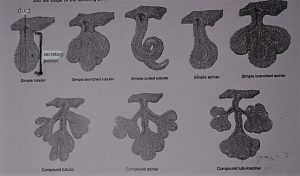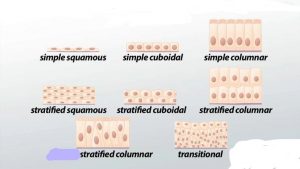Epithelial Tissue and MCQ for NEET, GPAT, NET JRF, GATE, Staff Nurse and Pharmacist Exam
Epithelial Tissue
The epithelium consist of cells arranged in continuous sheets, in either single or multiple layers. It covers the body and also lines the cavities, organs and tubes. The functions of epithelial tissue includes-
• Protection of underlying structures from dehydration, chemicals etc
• Secretion
• Absorption
The cells are closely packed and the intercellular substance is called is matrix, the cells lies on the basement membrane. The blood supply and nerves to the epithelial tissue is done with the adjacent connective tissue.
The epithelium is broadly divided into 2
1. covering and lining epithelium- this forms the covering and lining of body organs tubes etc. these are again divided-
I. Simple epithelium
• Simple squamous epithelium:– composed of single layer of flat cells. It lines heart, blood vessels, lymphatic vessels etc. its functions are diffusion, filtration, osmosis and secretion.
• Simple cuboidal epithelium:- consist of single layer of cube shaped cells, covers the surface of ovary and lines kidney tubules, anterior surface of lens of eye etc, functions include secretion and absorption.
• Simple columnar epithelium:- it is of two types
a. Ciliated columnar– consist of single layer of ciliated column like cells with nuclei and contain goblet cells, lines bronchioles, uterine, central canal of spinal cord etc, it moves mucous by ciliary action
b. Non-ciliated columnar:- consist of non ciliated column like cells and lines the GIT, ducts of many glands etc and functions for secretion and absorption.
II. Stratified epithelium
• Stratified squamous:– several layers of different cells from cuboidal to columnar cells but the apical layer contains flat cells. Keratinized lines the layers of skin while the non-keratinized lines pharynx, larynx vagina etc. the main function is protection
• Stratified cuboidal:– more than two layers of cells in which the apical layer contain cube-shaped cells, lines the ducts of adult sweat glands and part of male urethra. It works for protection, absorption and limited secretion.
• Stratified columnar:– several layers of different cells but apical layer has column like cells, lines urethra, excretory ducts and parts of conjunctiva of eye. Its functions are protection and secretion
• Transitional epithelium:– cells in the apical surface are variable from squamous (when stretched) to cuboidal (when relaxed). It lines urinary bladder and part of urethra and uterus, functions is that it permits distension.
2. Glandular epithelium- these make the secreting portion of glands. These are of two types-
• Endocrine glands:- hormones diffuse into blood from interstitial fluid, examples include adrenal glands pituitary gland, pineal gland, pancreas etc, functions is that the hormones released regulates body activities.
• Exocrine glands:- hormones released in the lymphatic ducts and then into the blood. Exocrine glands are classified on two basis-
1. Structural classification:- in this, the glands are classified as unicellular or multicellular. As the name suggest, unicellular are single celled glands; eg is goblet cells which secrete mucus.
Multicellular glands are composed of many cells. Multicellular glands are again divided in two parts
A. SIMPLE GLANDS
- simple tubular– in this the secretory portion is straight and is attached to the single unbranched duct; eg- glands of small intestine
- simple branched tubular– secretory portion is branched and is attached to single unbranched duct; eg- gastric glands
- simple coiled- secretory portion is coiled and is attached to unbranched duct; eg- sweat glands
- simple acinar – secretory portion is rounded is attached to single unbranched duct; eg- glands of penile urethra.
- simple branched acinar- the rounded secretory portion is branched and is attached to the unbranched duct; eg- sebaceous glands.
B. COMPOUND GLANDS
- compound tubular– secretory portion is straight and is attached to the branched duct; eg- bulbourethral glands.
- compound acinar– secretory portion is rounded and is attached to a branched duct; eg- mammary glands
- compound tubulo-acinar– secretory portion is both straight and rounded and is attached to a branched duct; eg- acinar glands of pancreas.

II. Functional classification:- it is done on the basis of how the secretory portion is released. these are of 3 types
- merocrine glands- secretions are synthesized on ribosomes attached to rough endoplasmic reticulum. Eg- salivary glands and pancreas
- apocrine glands- accumulate the secretory product at the apical surface of secreting cells. Eg- sweat glands
- holocrine glands– secretory portion is accumulated in the cytosol of the cell. Eg- sebaceous glands.

Multiple choice questions(MCQs)
1. How are cells arranged in epithelial tissue?
A. loosely packed B. closely packed in continuous sheets
C. arranged in discontinuous form D. both A and C
2. What is the function of epithelial tissue?
A. dehydration B. protection of underlying structures
C. absorption D. all of the above
3. Match the following-
a) transitional epithelium 1. Different cells in apical layer
b) simple columnar 2. Single layer of column like cells
c) stratified squamous 3. Several layers of cells and flat cells in apical surface
d)stratified cuboidal 4. Several cells but cube shaped cell in apical surface
4. Where is the stratified cuboidal epithelium present?
A. heart B. kidneys
C. spinal cord D. lymphatic tissue
5. Which type of cell is present in the apical surface of the transitional epithelium?
a. columnar B. squamous
C. cuboidal D. both B and C
6. What is the function of simple squamous epithelium?
a. protection B. negligible secretion
C. permits distension D. none of the above
7. Which of the following statement is true?
A. epithelial tissue has its own blood vessels and nerves
B. the basement membrane is present between the epithelium and adjacent connective tissue
c. cuboidal cells are present in transitional epithelium when stretched
D. the matrix lies on the apical surface
8. where is the keratinized squamous epithelium present?
A. skin B. blood vessels
C. urethra D. spinal cord
9. Which hormone is not the example of exocrine glands?
A. sebaceous glands B. adrenal glands
C. sweat glands D. salivary glands
10. Where is the simple squamous epithelium found?
A. skin B. blood vessels
C. urethra D. spinal cord
ANSWERS:-
1. closely arranged in continuous sheets
2. all of the above
3. a) – 1 b) – 2 c) – 3 d) – 4
4. kidneys
5. both B and C
6. none of the Above
7. the basement membrane is present between the epithelium and the adjacent connective tissue
8. skin
9. adrenal glands
10. blood vessels
Participate in Online FREE GPAT TEST: CLICK HERE
Participate in Online FREE Pharmacist TEST: CLICK HERE
Participate in Online FREE Drug Inspector TEST: CLICK HERE
Refrences:-Gerard J. Tortora -Principles of anatomy and physiology; edition twelfth ; page no.-: 112-121.